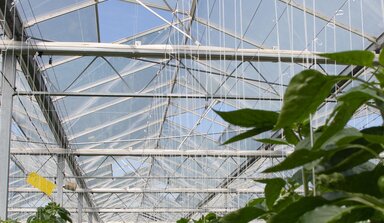Uniform light intensity best for crop
Plants show a delayed response to changes in light intensity. Actually they are always a few steps behind the reality and that reduces production. Diffuse light results in fewer changes and therefore to higher production.
If the light intensity in the greenhouse changes greatly, photosynthesis can be one third lower than when the light level stays steady. This is because the plant constantly has to get used to new circumstances.
Yet light changes continuously. Not only can a cloud move in front of the sun, light spots in the crop are constantly moving from place to place. In addition, the leaves themselves move so that they can be in or out of the light spots. The result is that there are always areas where the crop does not function optimally. Elias Kaiser of Wageningen University and Research has figured out which factors play a role and what the grower can do about them.
Stomata
It is well known that stomata need some time before they open to their maximum. This is particularly true at the start of the day. However, this is less important when the changes in light are rapid during the day. Then the stomata simply maintain their original position for a few minutes. More important is how the enzyme Rubisco functions. This plays a very important role in capturing CO2, one of the first steps in photosynthesis. This enzyme has an active and an inactive form. The switch from inactive to active can take from five to 20 minutes. This explains the delay in the plant’s response to changing light conditions.
ReduFuse
A grower can’t do anything about the specific characteristics of the enzyme but can do something about the conditions; these have a lot of influence on the speed of the response. Firstly, it’s important to prevent the light spots from continuously changing. By using ReduFuse, the light level in the greenhouse is much more uniform. The constant light level is an important explanation as to why a diffuse greenhouse roof leads to higher production. Namely the crop doesn’t constantly experience adjustment problems. The CO2-level in the greenhouse also plays an important role. At a low level (200 ppm) it takes at least 18 minutes before photosynthesis reaches the maximum. It takes just six minutes when the level is high (800 ppm). This is because the enzyme Rubisco is activated faster at a higher CO2-level, in addition to the fact that the opening of the stomata plays less of a role when the level is high.
Humidity
Finally, humidity is important. This has an effect on the opening of the stomata. They close more at a lower humidity so less CO2 can enter. This slows down photosythesis but also Rubisco is less active at a lower level.
In summary: Prevention of changes in light by using ReduFuse and ReduFuse IR increases production. Furthermore a high CO2-level and good humidity make a positive contribution to the crops ability to respond to changes in light that occur even when a coating is present – after all, a cloud can always pass by.


